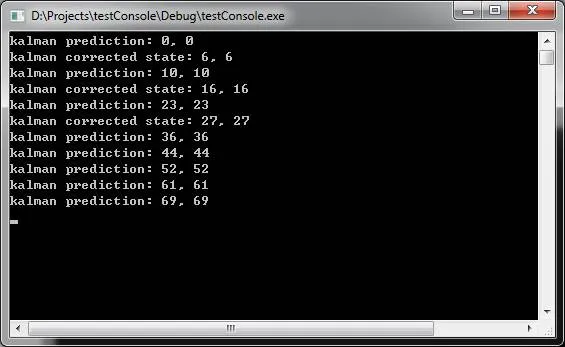我想使用Opencv Kalman滤波器实现平滑一些噪点。因此,我尝试编写了一个简单的测试代码。
假设我有一个观察值(一个点)。每个帧都会收到新的观察值,我调用Kalman预测和Kalman校正。OpenCV Kalman滤波器校正后的状态是“跟随点”,这很好。
然后假设我有一个缺失的观察值,我仍然希望Kalman滤波器被更新并预测新的状态。在这里我的代码失败了:如果我调用kalman.predict(),它的值就不再更新了。
这是我的代码:
#include <iostream>
#include <vector>
#include <sys/time.h>
#include <opencv2/highgui/highgui.hpp>
#include <opencv2/video/tracking.hpp>
using namespace cv;
using namespace std;
//------------------------------------------------ convenience method for
// using kalman filter with
// Point objects
cv::KalmanFilter KF;
cv::Mat_<float> measurement(2,1);
Mat_<float> state(4, 1); // (x, y, Vx, Vy)
void initKalman(float x, float y)
{
// Instantate Kalman Filter with
// 4 dynamic parameters and 2 measurement parameters,
// where my measurement is: 2D location of object,
// and dynamic is: 2D location and 2D velocity.
KF.init(4, 2, 0);
measurement = Mat_<float>::zeros(2,1);
measurement.at<float>(0, 0) = x;
measurement.at<float>(0, 0) = y;
KF.statePre.setTo(0);
KF.statePre.at<float>(0, 0) = x;
KF.statePre.at<float>(1, 0) = y;
KF.statePost.setTo(0);
KF.statePost.at<float>(0, 0) = x;
KF.statePost.at<float>(1, 0) = y;
setIdentity(KF.transitionMatrix);
setIdentity(KF.measurementMatrix);
setIdentity(KF.processNoiseCov, Scalar::all(.005)); //adjust this for faster convergence - but higher noise
setIdentity(KF.measurementNoiseCov, Scalar::all(1e-1));
setIdentity(KF.errorCovPost, Scalar::all(.1));
}
Point kalmanPredict()
{
Mat prediction = KF.predict();
Point predictPt(prediction.at<float>(0),prediction.at<float>(1));
return predictPt;
}
Point kalmanCorrect(float x, float y)
{
measurement(0) = x;
measurement(1) = y;
Mat estimated = KF.correct(measurement);
Point statePt(estimated.at<float>(0),estimated.at<float>(1));
return statePt;
}
//------------------------------------------------ main
int main (int argc, char * const argv[])
{
Point s, p;
initKalman(0, 0);
p = kalmanPredict();
cout << "kalman prediction: " << p.x << " " << p.y << endl;
/*
* output is: kalman prediction: 0 0
*
* note 1:
* ok, the initial value, not yet new observations
*/
s = kalmanCorrect(10, 10);
cout << "kalman corrected state: " << s.x << " " << s.y << endl;
/*
* output is: kalman corrected state: 5 5
*
* note 2:
* ok, kalman filter is smoothing the noisy observation and
* slowly "following the point"
* .. how faster the kalman filter follow the point is
* processNoiseCov parameter
*/
p = kalmanPredict();
cout << "kalman prediction: " << p.x << " " << p.y << endl;
/*
* output is: kalman prediction: 5 5
*
* note 3:
* mhmmm, same as the last correction, probabilly there are so few data that
* the filter is not predicting anything..
*/
s = kalmanCorrect(20, 20);
cout << "kalman corrected state: " << s.x << " " << s.y << endl;
/*
* output is: kalman corrected state: 10 10
*
* note 3:
* ok, same as note 2
*/
p = kalmanPredict();
cout << "kalman prediction: " << p.x << " " << p.y << endl;
s = kalmanCorrect(30, 30);
cout << "kalman corrected state: " << s.x << " " << s.y << endl;
/*
* output is: kalman prediction: 10 10
* kalman corrected state: 16 16
*
* note 4:
* ok, same as note 2 and 3
*/
/*
* now let's say I don't received observation for few frames,
* I want anyway to update the kalman filter to predict
* the future states of my system
*
*/
for(int i=0; i<5; i++) {
p = kalmanPredict();
cout << "kalman prediction: " << p.x << " " << p.y << endl;
}
/*
* output is: kalman prediction: 16 16
* kalman prediction: 16 16
* kalman prediction: 16 16
* kalman prediction: 16 16
* kalman prediction: 16 16
*
* !!! kalman filter is still on 16, 16..
* no future prediction here..
* I'm exprecting the point to go further..
* why???
*
*/
return 0;
}
我认为这段代码非常说明我的不理解之处。我尝试过遵循某些理论和一些实际例子,但仍然不明白如何获得未来位置的新预测。
有人可以帮助我理解我做错了什么吗?

cv::KalmanFilter::correct的作用。 - chappjc